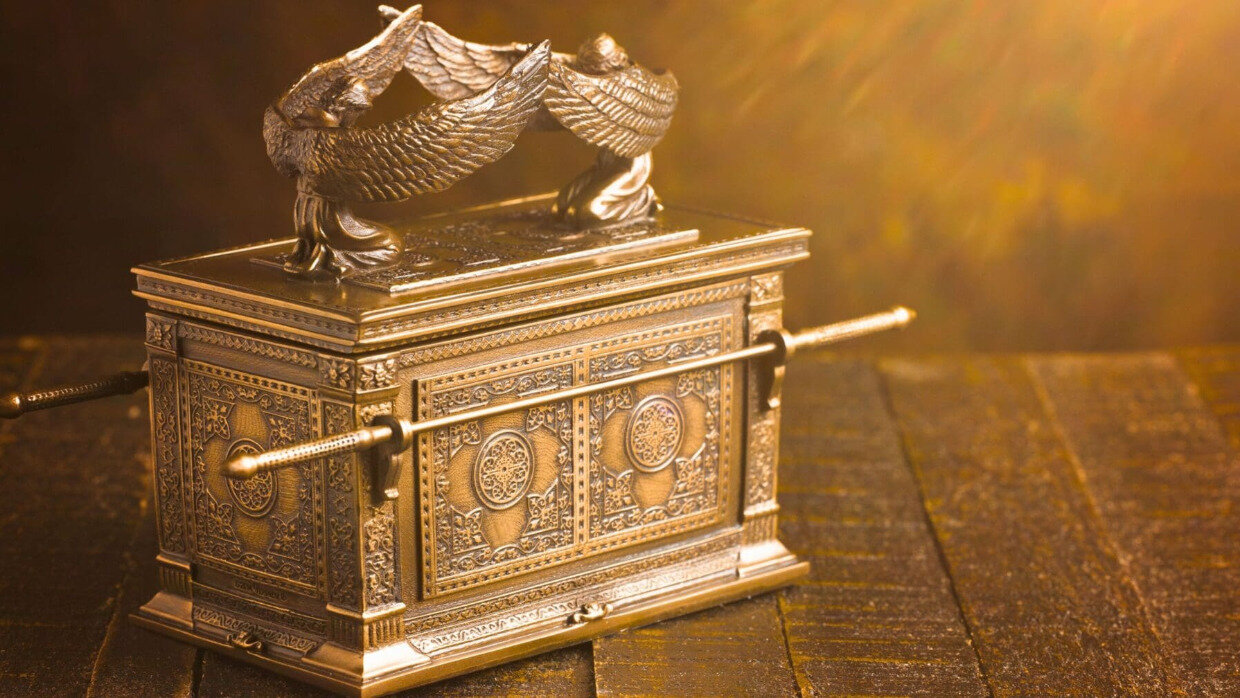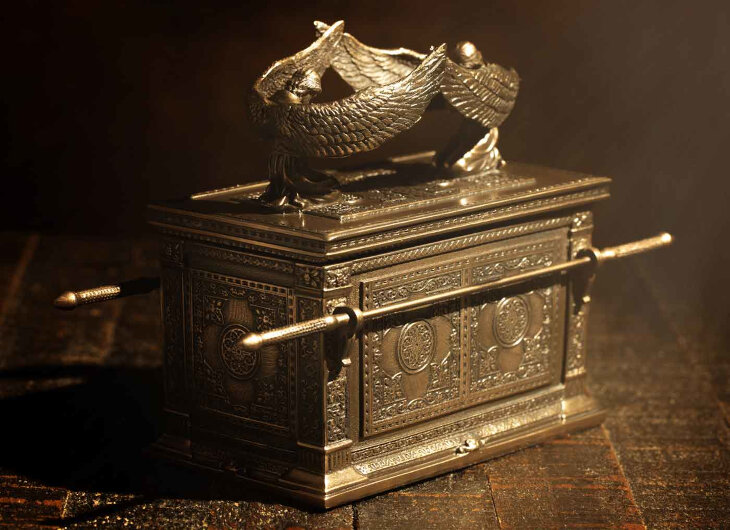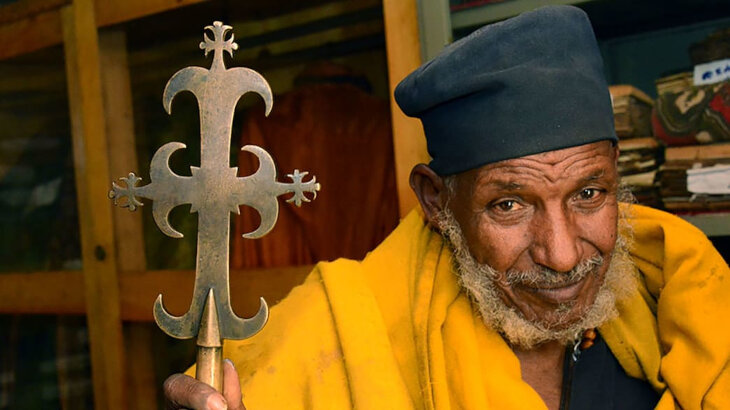 Vampire Weekend's Surprising Jewish Stories
Vampire Weekend's Surprising Jewish Stories


9 min read
The Ark of the Covenant is the holiest item in Judaism. What happened to it?
Does anyone know where the Ark of the Covenant is today? Was it taken by the Romans when the Temple was destroyed?
The Ark of the Covenant—its construction and function is described in the book of Exodus 25:10-22—was a box made of acacia wood covered with gold on the inside and out. Its cover was made of solid gold, which included two cherubs—or angelic figures that faced each other—that were about 30 inches tall. Opinions vary as to its weight and size, although depending on how the gold’s thickness is calculated, just the cover may have weighed as much as 2,500 pounds (other estimates put it at a more manageable 150 pounds).1 Two gold-covered wooden poles were attached to the Ark’s sides, and were used to carry it from place to place.
According to the Torah (Exodus 31:18), God gave Moses two tablets that had the Ten Commandments written on them, which Moses then broke upon seeing the Golden Calf (Exodus 32:19). Those broken tablets, along with a second set of tablets that Moses chiseled by hand at a later time (Exodus 34:1), as well as a Torah scroll that Moses wrote were stored inside the Ark.2
The Ark of the Covenant is mentioned numerous times in the Hebrew Bible, and at times is central to the Bible’s narrative. Examples include the book of Joshua, chapter 3, when the Jewish people cross the Jordan River and enter the land of Israel; Joshua 6, when they conquer the city of Jericho; Judges 20:27, when they sat and cried in front of it at the time of a civil war in Givah; Samuel I, chapters 4-6, when the Philistines captured it, were stricken with a plague, and then returned it; as well as many other instances.

The Ark was central to Jewish spiritual life, and its home in the Tabernacle—a portable tent of worship that the Jewish people used for about 400 years—was considered the holiest, focal point of Jewish spiritual life. When King Solomon constructed the first Temple in Jerusalem (Kings I chapters 6-8)—the Western Wall in Jerusalem’s Old City is the remains of the retaining wall from the Second Temple, built centuries later—the Ark’s home was considered the Holy of Holies.
Ironically, despite the Ark’s importance, it’s not mentioned at the end of the book of Kings (Kings II, chapter 25), when the Babylonians destroyed Jerusalem and the Temple, and carted off the Temple’s treasures—some of which are listed amongst the spoils of war—to Babylon.
According to Jewish tradition, that omission is on purpose, and indicates that the Ark was possibly hidden away years before the Babylonian conquest.
One opinion states that Josiah—a righteous Judean king and reformer, mentioned in Kings II 22—understood that the Temple would be destroyed, and hid the Ark3 along with other significant items like the jar of Manna mentioned in Exodus 16:32-34, the special anointing oil used to inaugurate the king and high priest (Exodus 30:22-33), and the staff that belonged to Aaron, which miraculously blossomed (Numbers 17:25).
Although another opinion4 holds that the Ark was indeed taken to Babylon at the time that the Babyloniand king, Nebuchadnezzar, conquered Jerusalem and exiled Jeconiah, the Jewish king, as well as the upper classes (Kings II 24:8-18). (Nebuchadnezzar installed Jeconiah’s uncle, Zedekiah, as king for another eleven years, until the final invasion and the Temple’s destruction in 422 BCE). Chronicles II 36:10 states that Nebuchadnezzar exiled Jeconiah to Babylon along “with the precious utensils of the House of God,” implying that one of those “precious utensils” may have been the Ark of the Covenant.5
During the Second Temple period, the Ark never resurfaced, and the Holy of Holies was left empty. Needless to say, when the Romans sacked Jerusalem and destroyed the Second Temple in the year 70, the Ark could not have been included amongst the booty they brought back to Rome.
In addition to missing the Ark of the Covenant, the Second Temple also lacked a tangible experience of God’s presence (called the “Shechinah”), a miraculous fire from heaven, and the Urim and Thummim, which was parchment, placed inside the fold of the High Priest’s breastplate, and that included the ineffable four-letter name of God.6 It was still possible to do the Temple service without these things, but the Second Temple was not considered to have the same degree of sanctity.
According to one opinion, the Ark was hidden somewhere under the site of the ancient Temple. When King Solomon first built the Temple, he designed a complex arrangement of tunnels beneath it, including a hiding place for the Ark in the event that the Temple was destroyed. That was where Josiah hid the Ark centuries later.7 The Talmud8 also notes that the Tabernacle from Moses’s time was hidden in tunnels beneath the Temple Mount. In modern times, some efforts were made to excavate the area, but were not successful due to the politically contentious nature of the site.
Another opinion, cited in the Book of Maccabees II 2:4-10, is that the prophet Jeremiah, knowing the Babylonians would soon invade, took the Ark and several other sacred items from the Temple and hid them in a cave on Mount Nebo—the mountain Moses ascended before died—which is now in present-day Jordan.
“It was when they came to the mountain that Moses ascended to see the land that Jeremiah found a cave there and he hid the Tent of Meeting, the Ark, and the Incense Altar in it, and he closed [the cave's] opening.”9
According to the Ethiopian national epic, Kebra Nagast (the Glory of the Kings), King Solomon fathered a son, Menelik I, with the Queen of Sheba. Menelik later went to visit his father, and on his return journey was accompanied by the firstborn sons of some Israelite nobles, who, unbeknown to Menelik, stole the Ark and carried it with them to Ethiopia. When Menelik learned of the theft, he reasoned that since the Ark's frightful powers hadn't destroyed his retinue, it must be God's will that it remain with him.10
 Is this Ethiopian monk guarding the Ark of the Covenant? Don’t bet on it.
Is this Ethiopian monk guarding the Ark of the Covenant? Don’t bet on it.
According to some, the Ark is hidden within the belly of the Church of Our Lady Mary of Zion, in Aksum, Ethiopia. However, during World War II, Edward Ullendorff—who at the time was an officer in the British army, and already a scholar of Ethiopian history and language—claims to have muscled his way into the church past the guards, and found a model of an ark that was typical of the type of arks found in many Ethiopian churches. According to reports, “it wasn’t ancient, and certainly not the original.”11
A number of other theories link the Ark to Ethiopia as well, although none of them seem to stand up under academic scrutiny.
As mentioned above, the Ark, ultimately, was a box that held the two tablets that Moses broke after seeing the Golden Calf, the second set of tablets Moses chiseled by hand, and the complete Torah scroll that Moses wrote.
The Ark is considered the holiest item in Judaism, and the focal point of Jewish spiritual life, yet its contents, the Torah and commandments, are accessible to everyone. Judaism is not elitist. Rather, God gave humanity the necessary tools to understand the world He created and to establish a relationship with Him. The Torah is the secret to living a purposeful and meaningful life, and it’s yours for the taking.
On a mystical level, according to the Talmud,12 the Ark didn’t take up any space. Despite being a physical object, when placed in a room measuring 20 cubits (about 40 feet), the measurement from the wall to each side was 10 cubits, meaning that it was there, but it wasn’t. The Ark, and its contents, the Torah, is the interface between this world and the deepest levels of spirituality. As you plumb its depths—while still rooted in the mundane, physical world—you learn how to see your reality from an elevated, spiritual, and more enlightened perspective.
No. People have looked for it, but no one has found it. Attempts were made to excavate under the Temple Mount in Jerusalem, but those were halted for political reasons.
The Ark of the Covenant is a box that held the two tablets that Moses broke after seeing the Golden Calf, the second set of tablets he later chiseled by hand, and the complete Torah scroll that he wrote at the end of his life.
The Ark of the Covenant was initially kept in the Tabernacle that the Jewish people traveled with in the desert (see Exodus 26). For most of the early biblical period, it was kept in Shilo (in modern-day central Israel), until it was moved to its permanent home in Jerusalem during the reign of King Solomon. Nowadays its whereabouts are unknown.

Where isn't it ...... you sure it looks like that? SG MM 2610
So if the Ark of the Covenant is found, so what? Only the Kohen Gadol is allowed to touch it - but there isn't one!
The representatives of the Ashkenazim, Sephardim, Mizrahim and Beta Israel would have to meet in a grand conference to appoint one and his authority would have to be recognised by the entire Jewish World. He would, in effect, be the Jewish Pope.
And even if the Kohen Gadol was appointed, would he open the Ark of the Covenant? Would he even want to?
To hold the Tablets of God and Moses in his hands? Which man would take such an awesome responsibilty? He would quake with fear in front of the Ark.
And where would the Ark be kept? The Third Temple would have to be built to store the Ark. But to do that, Israel would have to go to war with the entire Muslim world.
I assume the Ark is hidden somewhere on the Temple Mount. It could not be transported very far on the shoulders of four men without many people seeing it. Pictures of the caves under the Mount show many rooms and dark passage ways. To check everything a systematic search using sonar would at least cover every hidden room.
I visited the possible location of the Ark in Ethiopia on Debra Damo in the 1960s. Here is my story: https://nowoezone.com/Ark_of_the_Covenant.htm.
Hi Ken, thanks for the interesting read.
Just one observation though, you mentioned "a prophesy that ... the Jews are re-gathered as a nation. Didn't that happen a little over 70 years ago?" The answer is - no. We are greatful to HaShem that we are able to come and live in Eretz Yisroel once more, but it is certainly not yet the fulfilment of the nevuah.
Why the emphasis on an object? We should focus on the one who commanded the ark to be built on the first place. Our focus should be on God alone and not on the ark or the temple
The picture you show has the poles on the wrong side. They were along the narrow side so that two carriers could stand in between.
The comment that the Arks contents - are accessible to everyone - appears to be - incorrect. It was in the MISHKAN’S Holy of Holies - & accessible to ONLY THE KOHEN GADOL! Aarons sons were killed - going before it - to offer PROFANE INCENSE! When the Ark was being brought back to Jerusalem- during the time of David - UZZA who was escorting the Ark - WAS KILLED - when he TOUCHED THE ARK - TO PREVENT 9IT FROM FALLING.
I don’t think the physical contents (ie, the objects) were meant, rather the knowledge which is available in every Torah scroll and printed bible.
Drivah - I'm being a bit of a stickler here - about the wording - "The Ark is considered the HOLIEST ITEM IN JUDAISM ...... - and the focal point of Jewish spiritual life, yet its contents, the Torah and commandments, are accessible to everyone.". As it's written - IT IMPLIES THAT - "THE CONTENTS" OF THE ARK - ARE ACCESSABLE TO EVERYONE. AGAIN - AS I STATED BEFORE - ONLY THE KOHEN GADOL - CAN TOUCH the ARK & THOSE CONTENTS!
YES - the rest of the text - alludes to hearing - learning & keeping G-D's Written Torah and Commandments AS HE GAVE THEM TO US.
Thanks Gershom, the article does not say the Ark itself was accessible to everyone, just its contents, the Torah and commandments. That doesn't mean the actual stone tablets or Torah scroll that were stored inside the Ark. Rather, it means that the Torah and commandments are the heritage of the Jewish people, and you don't need to be a priest, king, of person of privilege to study them, they're accessible to everyone.
Could we get a FAQ - What would happen if the Ark was found?
Suppose the Ark is found who would be brave enough to touch it and take the 10C out of it. Suppose that person dies. Whoever can handle the 10C would be considered by the Christian, Jewish and Muslim religions as holy.
According to a programme on TV a few months ago, the Ark is in the custody of Freemasons of Jerusalem and underground in the City of David part of Jerusalem. Those Freemasons will not confirm that, for obvious reasons .
There is no end to the many wild and crazy conspiracies have been connected with and blamed on the Freemasons and "Zionists", including world domination. The original Grand Lodge was formed in London more than 300 years ago, suggesting that Masons and co-conspirators are not very efficient in dominating much of anything. Some of the concordant bodies of Freemasonry do make reference to the Hebrew Bible (Solomon, David, the re-building of Jerusalem and the Temple following the return of the exiles from the Babylonian captivity, the Ark etc.). Thanks to Dan Brown (The DaVinci Code) these non-sensical conspiracy theories have grown. Despite Brown's clear words that his book is a work of fiction, many gullible people take it as serious history. Indian Jones didn't find the Ark either.
You might want to know what all Mr Ron Wyatts found beneath Golgotta with his team in 1982 as they witnessed strange circumstances. They also had to terminate the research... Just remember we all have the same Creator and that His day is coming very soon. He will not ask about your religion, but examine what is in your heart, if you accept Truth and Justice from His hands.